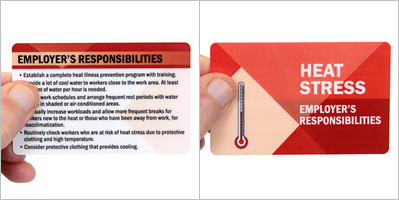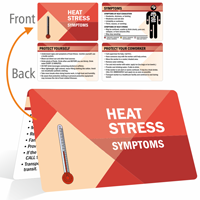Different types of heat stress
Heat stress is common among workers like firefighters, factory workers, miners, bakers, and farmers, who are exposed to high temperatures, whether indoors or outdoors. Heat stress at workplace is the combined result of body heat generated through physical exertion, environmental factors, and the clothes you wear.

Heat stress takes various forms in heat-related illnesses like heat stroke, heat exhaustion, heat cramps, and heat rashes. Let us look at all types of heat stress in detail.
Heat Stroke
Heat stroke is the most severe form of heat-related illness. In case of a heat stroke, the person is unable to regulate body temperature, which can rise to 1060F or more in just 10 to 15 minutes. As the body fails to dissipate heat, the body’s natural cooling mechanisms begin to fail and this could result in death or disability.
Symptoms of Heat Stroke
- Confusion, altered mental status, slurred speech
- Loss of consciousness
- Hot, dry skin, or profuse sweating
- Seizures
First Aid for Heat Stroke
- Call 911
- Stay with the worker until emergency medical services arrive
- Transfer the patient to a shaded, cool area and take off their outer clothing
- Cool the worker quickly with a cold water or ice bath if possible; wet the skin, place cold, wet clothes on skin, or soak clothing with cool water
- Circulate air around the worker to speed cooling
Heat Exhaustion
Heat exhaustion is the body’s response to excessive loss of water and salt through vigorous sweating. In hot environments, seniors or workers with high blood pressure are at a higher risk of heat exhaustion.
Symptoms of Heat Exhaustion
- Headache
- Nausea
- Dizziness
- Weakness
- Irritability
- Thirst
- Heavy sweating
- Low urine output
First Aid for Heat Exhaustion
- Take the worker to get medical treatment
- If medical care is unavailable, call 911
- Accompany the worker until help arrives
- Remove the worker from hot area and feed liquids
- Remove unnecessary clothing, including shoes and socks
- Cool the worker with cold compresses or have the worker wash their head, face, and neck with cold water
- Encourage frequent sips of cool water
Heat Cramps
Heat cramps are also a form of heat exhaustion. When the body sweats extensively, the body’s salt and moisture levels drop, causing painful cramps.
Symptoms of Heat Cramps
- Muscle cramps, pain, or spasms in the abdomen, arms, or legs
First Aid for Heat Cramps
- Get medical help if the worker has heart problems, is on a low sodium diet, or if cramps do not go away within an hour.
The Centers for Disease Control and Prevention advise workers with heat cramps to consume water or energy drinks and to have a snack every 15 to 20 minutes. They should also avoid salt tablets.
Heat Rashes
Heat rash or prickly heat is skin irritation caused by extreme sweating during hot, humid weather.
Symptoms of Heat Rash
- Red clusters of pimples or small blisters. They mostly appear on the neck, upper chest, groin, under the breasts, and in elbow creases.
Preventive Measures for Heat Rash
- Create a cooler, less humid work environment
- Keep rash area dry
- Apply powder
- Do not use ointments or creams
According to the Bureau of Labor Statistics (BLS), 37 workers died due to environmental heat exposure and 2,830 workers suffered nonfatal occupational injuries and illnesses in 2015.
Occupational heat stress occurs more quickly than one may realize. Employers must have effective prevention programs at the workplace to control heat stress. This includes acclimatizing workers to the heat, scheduling work earlier or later in the day, encouraging workers to take breaks in shade and encouraging workers to hydrate themselves by drinking 1 cup of water every 15–20 minutes. Employers should also provide hats and light-colored, heat-protective clothing to workers.
Category: Resources














